
3291
.pdf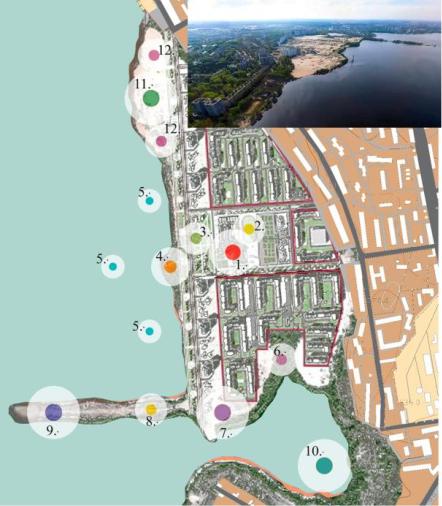
Issue № 3(31), 2016 |
ISSN 2075-0811 |
Planning these areas is a complex and multi-faceted task that has to be addressed by having an urban construction plan in place based on the analysis of an area to be developed. The area around the Voronezh water reservoir can be used as an example of that (Fig. 1).
This construction area is restricted from the East and South by a residential construction and from the West by the basin of the Voronezh water reservoir, from the North by industrial and infrastructural objects.
The residential buildings were about 5—17 storeys high and there are plans to build a new residential district mainly consisting of 10-storeyed large-panel buildings along the shore. The core of the construction will be a public area including a park zone, schools and shopping and entertainment centres. The development of this area will be detailed in the graduate paper ―Designing the Environment of a Hydraulic Area in Zheleznodorozhniy District of Voronezh‖ (by A. A. Melnikov, A. Yu. Petrova supervised by N. V. Valuyskay). The main objective of the project is to design an architectural environment meeting the social, cultural and functional requirements for modern cities and organization of a vibrant public space in a particular area.
Fig. 1. Scheme of a functional zoning of a construction area:
1 is a multifunctional shopping and entertainment centre; 2 is a stadium;
3 is a landscape park; 4 is a stage area; 5 are fountains; 6 is a pier; 7 is a yacht club; 8 is a summertime café; 9 is a boathouse;
10 is a bay; 11 is a sports equipment rental; 12 is a recreational area (beach)
81

Scientific Herald of the Voronezh State University of Architecture and Civil Engineering. Construction and Architecture
Due to the challenges associated with connecting the existing and designed objects as well as extensive construction areas, the concept of the development of hydraulic areas is based on the method of architectural bionics (Fig. 2) according to the golden section, golden spiral rules, dimensionality system ―Modulor‖ [1—3].
Fig. 2. Concept of the development of a construction area
The important factor of the project is a new approach to designing recreational areas, i.e. combining objects of different purposes and ordering them from close to open ones. In addition to architectural, artistic, functional and aesthetic factors, territorial planning of the district in question is impacted by its engineering and transport infrastructure. Therefore all of the suggested architectural, landscape and engineering solutions should be on par and complimentary to one another.
1. Suggested architectural and planning solutions. The area in question is suggested to be divided into a few functional areas: entertainment (including a stage area, fountains, landscape park, cycling paths, wi-fi lounges, relaxation areas, amusement park, beach); shopping and sports area. Fig. 3. shows a perspective view of the designing solution for the area.
82
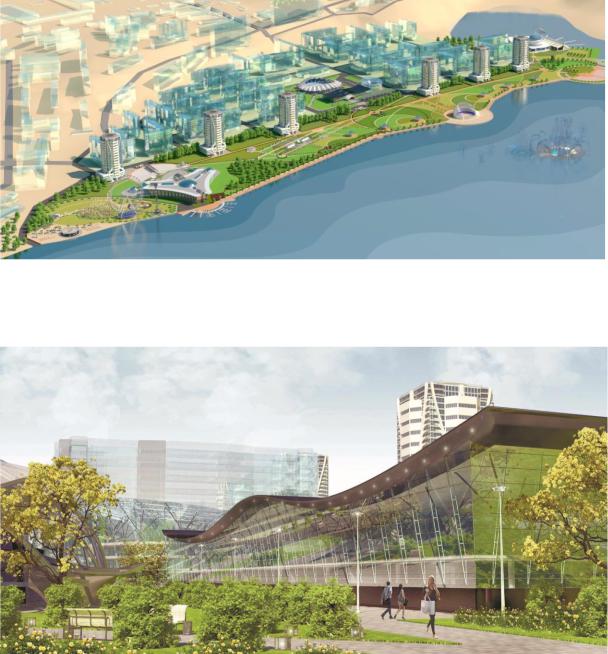
Issue № 3(31), 2016 |
ISSN 2075-0811 |
Let us look more closely at some typical architectural and planning features of the major objects of the area. The shopping and entertainment buildings is shaped like a wave and a lot of glass reflects what is around and makes it feel as a deep sea. There are round light bulbs in the roof that adds to the feeling of comfort. The facades are made of hardened glass that convey a sense of lightness (Fig. 4).
Fig. 3. Perspective view of the construction area
Fig. 4. Shopping and entertainment building
83
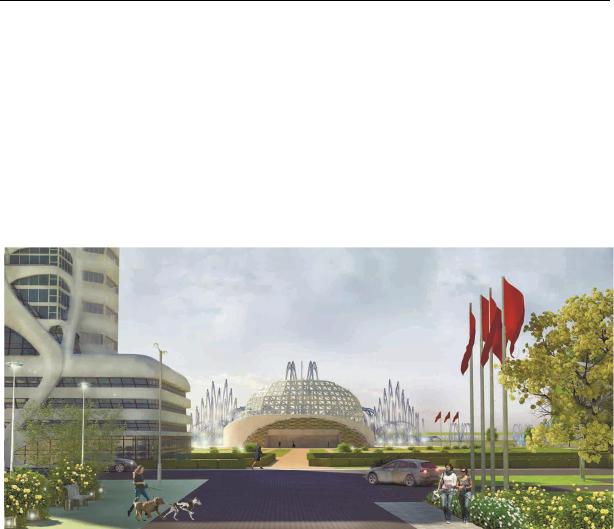
Scientific Herald of the Voronezh State University of Architecture and Civil Engineering. Construction and Architecture
The visual axis of the central street is finished with an open stage area. The main parameter critical to the size and shape of the stage is the size of the playground. The construction of the audience hall is adjacent to the stage and the arrangement of what is going on at the stage. The stage area is a laced structure with a monolith foundation. The shuttering technology is employed to make the shape of the stage more flexible. The metal carcass crushing into the cast mass of the concrete is decorative and gives a light and lace feeling. It also allows the tent structures and decorations to be put onto (Fig. 5).
Fig. 5. Open stage area
The main concept behind the stadium is an image of a lotus that is fully in agreement of the main concept of the project overall (Fig. 6). A bionic image of the building is created by a tent structure that relies on a metal carcass. It adds a light and aesthetic touch. The tent structure is spread over the seat gallery to protect the visitors against a rainfall. The sports stadium is made of lightened structures and its exterior and interior facing consists of modern energysustainable and fire-resistant materials with advanced performance characteristics.
Along the perimeter of the park there are large hardwood trees protecting the area against rainfalls and noises and thick decorative bushes serve to keep the park together structurally and create a range of small intimate areas around the park. There are also retaining walls in place. Along the vegetation area there are interactive paths and the park exit is positioned as a result of an elaborate urban planning analysis of this particular area. A network of pavements and paths is designed with the consideration of all types of traffic.
84
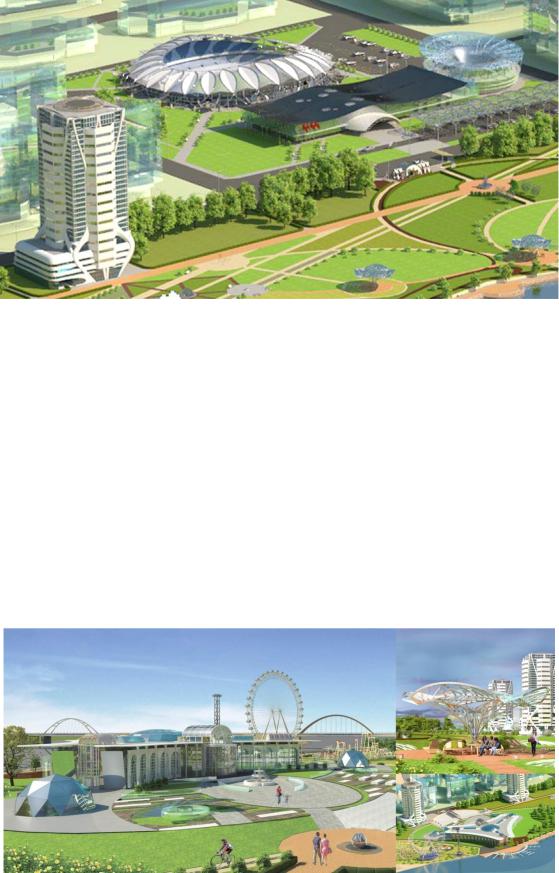
Issue № 3(31), 2016 |
ISSN 2075-0811 |
Fig. 6. Perspective view of the stadium and shopping and entertainment building
Pedestrian and cycling routes are designed to be separate and there are also parking spaces. There are also wifi-libraries that look like fairytale-like mushrooms. The facades of these buildings are made of a metal rod carcass filled with polycarbonate and creating a web of shadows. Polycarbonate dissipates the light and creates ambience as well as protects against rainfalls. The entertainment area is a complex structure including an atrium. This dome structure is a pivotal point of the entire area. It is located in the centre with light bulbs coming out like rays which are prolonged arches with metal carcasses. Inside it there is a grid of light diodes creating a starry sky effect. A lot of glass used in the facades gives a panoramic view of the area and fits in perfectly with the landscape of the water basin (Fig. 7).
Fig. 7. Amusement park area and wi-fi library
85
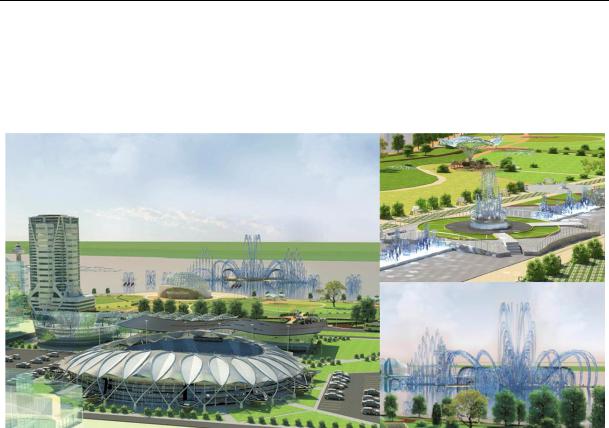
Scientific Herald of the Voronezh State University of Architecture and Civil Engineering. Construction and Architecture
The project make provisions for special water fountains in the central part of the water basin. The fountains can stage light shows and be part of the decorations for the open stage area. One can also find a fountain alley as they stroll further into the park (Fig. 8).
Fig. 8. A fountain alley in the park
2. Arrangement of an engineering and transport infrastructure on the planning area.
Territorial planning of the water basin in question involves a maximum reduction of the intersections with the transport and pedestrian flows. Vehicles travel immediately along the park where there are cycling paths. There are also cycling parking spaces, cycling rentals and cycling routes at the edge of driveways and roads. For the convenience of the residents of the adjacent smaller districts and visitors of the park there are plans to build a network of bus stops. For visitors of the shopping and entertainment area and the stadium there is a multi-storeyed land parking and a roofed parking lot (Fig. 9).
The multi-storeyed parking lot is completely automatic. It is designed as a round tower that occupies 20 percent less land than traditional parking lots. A light image of a vertical car parking resembles a water funnel faced with glass on a metal carcass that hides a complex ferroconcrete structure inside it to provide a high-class fire resistance. Spider glassing allows the whole façade to be glassed and thus seem light. A translucent structure has high strength characteristics and ideally even glass surface with an invisible carcass.
86
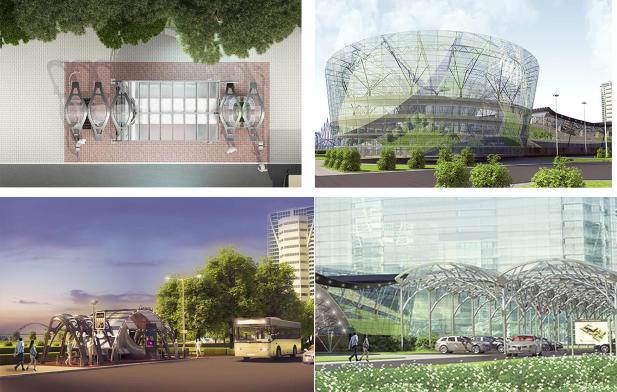
Issue № 3(31), 2016 |
ISSN 2075-0811 |
Fig. 9. Parking area
Conclusions
The suggested functional zoning allows a vibrant public space including an entertainment, recreational, shopping, etc. areas. The suggested variant of a territorial zoning of the district contributes to the architectural and artistic image of this part of it taking on board the requirements for the arrangement of an engineering and transport infrastructure and caters for social, cultural and functional needs of modern cities. In addition, all of the above improve the functional and compositional properties of the existing and designed residential construction area.
References
1.Drunvalo M. Drevnyaya tayna tsvetka zhizni [The ancient secret of the flower of life]. Moscow, Sofiya Publ., 2013. 304 p.
2.Aleksashina V. V., Chernyshov Ye. М., Chuykin S. V., Melnikova А. А. The concept of redevelopment of the historical centre of the village Kantemirovka, Voronezh region. Scientific Herald of the Voronezh State University of Architecture and Civil Engineering. Construction and Architecture, 2015, no. 2 (26), pp. 88—101.
3.Sculptural Wooden Furniture by Joseph Walsh. Available at: http://www.home-draft.com/2013/06/16/ sculp- tural-wooden-furniture-by-joseph-walsh
87

Scientific Herald of the Voronezh State University of Architecture and Civil Engineering. Construction and Architecture
4.Grabova P. G., Kharitonov V. A., eds. Rekonstruktsiya i obnovlenie slozhivsheysya zastroyki gorodov [Reconstruction and upgrade of the existing development of cities]. Moscow, ASV Publ., Realproekt Publ., 2006. 624 p.
5.Enin A. E. Gradostroitel'noe razvitie malykh istoricheskikh gorodov Chernozem'ya [Urban development of small historical cities of Chernozem region]. Nauchnyy vestnik Voronezhskogo GASU. Stroitel'stvo i arkhitektura, 2008, no. 4, pp. 9—18.
6.Enin A. E., Surovtsev I. S., Litvinova T. A. Problemy gradostroitel'nogo razvitiya malykh istoricheskikh gorodov Voronezhskoy oblasti: retrospektivnyy analiz i prognozirovanie [Problems of urban development of small historical towns of the Voronezh region: a retrospective analysis and forecasting]. Nauchnyy vestnik Voronezhskogo GASU. Stroitel'stvo i arkhitektura, 2011, no. 4, pp. 188—195.
7.Yenin A. Ye., Molodykh M. S. Problems Of Architectural Heritage Maintenance By The Example Of Country Estates Of The Central Chernozem Region. Scientific Herald of the Voronezh State University of Architecture and Civil Engineering. Construction and Architecture, 2010, no. 3, pp. 59—73.
8.Mel'kumov V. N., Chuykin S. V., Papshitskiy A. M., Sklyarov K. A. Modelirovanie struktury inzhenernykh setey pri territorial'nom planirovanii goroda [Modeling of the structure of utility networks the regional planning city]. Nauchnyy vestnik Voronezhskogo GASU. Stroitel'stvo i arkhitektura, 2015, no. 2 (38), pp. 41—48.
9.Peters E. V. Gradostroitel'stvo i planirovanie naselennykh mest [Urban planning and planning of settlements]. Kemerovo, Izd-vo KuzGTU, 2005. 163 p.
10.Khasieva S. A. Arkhitektura gorodskoy sredy [The architecture of the urban environment]. Moscow, Stroyizdat Publ., 2001. 200 p.
88
Issue № 3(31), 2016 |
ISSN 2075-0811 |
INSTRUCTIONS TO AUTHORS
1.General Requirements. Contributions reporting original research or reviews and analyses dealing with aspects of environmental quality in natural and agricultural ecosystems will be considered from all disciplines, and from both members and nonmembers, by the editorial board.
To be acceptable a manuscript must make a significant contribution to the advancement of knowledge or toward a better understanding of existing concepts. The study should define principles of broad applicability, be related to problems over a sizeable geographic area, or be of potential interest to a representative number of scientists.
The minimum length for the manuscript is six pages.
The manuscript should be written in English in a clear style.
2.Creating the Manuscript File. Accepted manuscripts are prepared for typesetting with a word processing file. Therefore, authors should compose the manuscript in Word.
The file should contain the following elements:
Title page;
Abstract;
Text;
References list;
Figures;
Tables.
3.Notice for Word 2007 Users. If you have equations, they must be composed using MathType. Do not use INSERT EQUATION, which creates images (when converted) that cannot be used for typesetting.
4.Title Page. The title page should include:
1.A short (<12 words) title that accurately identifies and describes the manuscript content.
2.An author-paper documentation list, with author name(s), affiliation, and complete address(es).
3.Author should avoid the use of non-standart abbreviations.
4.The corresponding author’s email address.
5.Abstract. Include an informative, self-explanatory abstract, containing not less than
250words. The main sections are problem statement, results, and conclusions. It should be
89

Scientific Herald of the Voronezh State University of Architecture and Civil Engineering. Construction and Architecture
specific, telling why and how the study was made, what the results were, and why they were
important. Use quantitative terms where possible.
6.Text. The main text of the manuscript typically includes an introduction, structural elements specific to each article, and conclusions.
7.References
Arrange the list alphabetically by the surnames of the first authors and then by the second and third authors.
Single-authored articles should precede multiple-authored articles for which the individual is senior author.
Two or more articles by the same author(s) are listed chronologically; two or more in the same year are indicated by a, b, c, etc.
8.Figures. If the manuscript has figures, spell out abbreviations on first mention in figure captions, even if they have already been defined in the text. (The reader should be able to understand the figure content without referring back to the text).
9.Consent and Permissions. Authors are responsible for obtaining all permissions for use of figures from other publishers and should supply these releases at the time the accepted manuscript is forwarded for production. Authors are also responsible for obtaining permission from individuals whose images are included in photographs.
Questions?
Contact us! (vestnik_vgasu@mail.ru)
Revised June 2016
90
